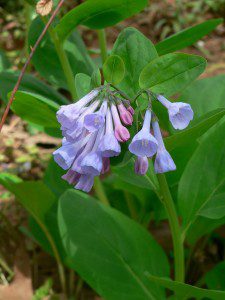Plant Sale Profile: Mertensia virginica
 Mertensia virginica is a member of the Borage (Boraginaceae) family. Commonly called Virginia Bluebells, its also known as Virginia Cowslip, Roanoke-bells, Eastern Bluebells and Lungwort Oysterleaf.
Mertensia virginica is a member of the Borage (Boraginaceae) family. Commonly called Virginia Bluebells, its also known as Virginia Cowslip, Roanoke-bells, Eastern Bluebells and Lungwort Oysterleaf.
When the leaves emerge they are a lovely shade of purple, quickly turning a medium green as they increase in size. Although the flowers are usually light blue, persistently pink or white-flowered forms have occurred. The light blue blooms start out pink as buds, changing to blue, nodding bell shaped flowers as they mature and once pollinated turn pink again. The cluster of flowers are very showy. Blooming lasts about three weeks in April after which Mertensia virginica being spring ephemerals disappear in early summer. Pair with other natives such as Maidenhair Fern (Adiantum pedatum), Christmas Fern (Polystichum acrostichoides), Woodpoppy (Stylophorum diphyllum), Bugbane (Cimicifuga racemosa) or Jacob’s Ladder (Polemonium reptans) to fill in the space once the plants disappear (remembering to mark where the Mertensia virginica is planted while the plants are above ground so you don’t damage them when planting around them later). Plants
they mature and once pollinated turn pink again. The cluster of flowers are very showy. Blooming lasts about three weeks in April after which Mertensia virginica being spring ephemerals disappear in early summer. Pair with other natives such as Maidenhair Fern (Adiantum pedatum), Christmas Fern (Polystichum acrostichoides), Woodpoppy (Stylophorum diphyllum), Bugbane (Cimicifuga racemosa) or Jacob’s Ladder (Polemonium reptans) to fill in the space once the plants disappear (remembering to mark where the Mertensia virginica is planted while the plants are above ground so you don’t damage them when planting around them later). Plants  grow about 2 feet tall and should be planted about 10” apart. Mertensia virginica thrives in rich soils of well-drained floodplain forests, low-elevation cove forests, and mesic slope forests. Locally common throughout the mountains (lower elevations only) and the Piedmont. It will colonize in optimum conditions, seeding freely. Consider planting Mertensia virginica for pollinators. Bumblebees, long-tongued bees, hummingbirds, syrphids, butterflies and moths all visit this plant. Mertensia virginica is not preferred by deer.
grow about 2 feet tall and should be planted about 10” apart. Mertensia virginica thrives in rich soils of well-drained floodplain forests, low-elevation cove forests, and mesic slope forests. Locally common throughout the mountains (lower elevations only) and the Piedmont. It will colonize in optimum conditions, seeding freely. Consider planting Mertensia virginica for pollinators. Bumblebees, long-tongued bees, hummingbirds, syrphids, butterflies and moths all visit this plant. Mertensia virginica is not preferred by deer.
